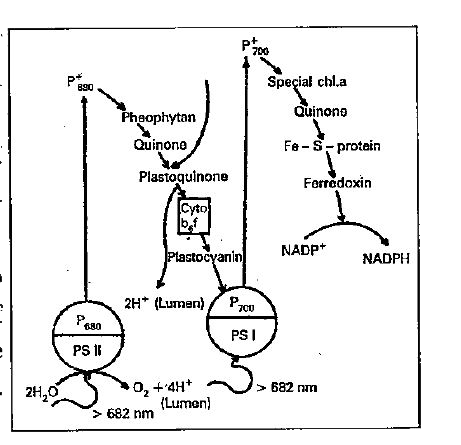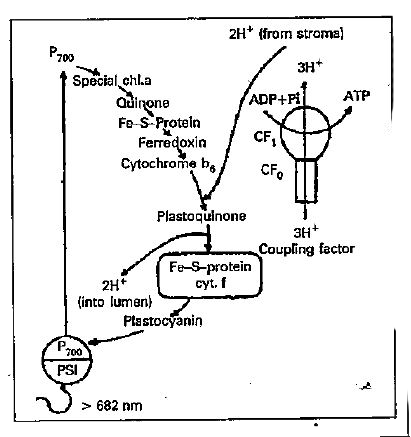In both cyclic and non cyclic Photophosphorylation/electron transportSolution in Telugu
Electron transport and mechanism of ATP formation : The synthesis of ATP from ADP and Pi in presence of light within the chloroplast is called photophosphorylation. It is of two types - viz., non-cyclic photophosphorylation and cyclic photophosphorylation.
Non-cyclic photophosphorylation : In chloroplasts, the electrons continuously supplied from water, are transported to photosystem-II, to photosystme-I and finally to NADP+ which is reduced to NADPH. This transport of electrons is called non-cyclic electron transport. Formation of ATP in association with non-cyclic electron transport is called non-cyclic photophosphorylation.
Non-cyclic electron transport requires two large, multimolecular complexes called as photosystem - I and photosystem - II. The two complexes operate in series and are linked by electron carrier molecules. The photo systems and electron carriers are arranged in the thylacoid membranes of chloroplasts.
Photosystem-I consists of several molecules of chlorophyll a, some molecules of chlorophyll b and some β-carotene molecules. The reaction centre of PS-I consists of four to six molecules of chlorophyll a and is designated as P700. Light harvesting complex I (chlorophyll-protein complexes) is associated with PS I. PS I is activated by red light of longer wavelength (> 682 nm) when PS I absorbs red light, the absorbed light energy is transferred to P700. It is first excited and then oxidized. The electron released from P700 is transferred to a special chlorophyll a. The electron is then passed through quinone and Fe-S-proteins and finally to ferredoxin. From ferredoxin, electron is transferred to NADP+ which is reduced to NADPH. This reduction takes place in the stroma and catalysed by the enzyme ferredoxin NADP+ oxidoreductase.
Photosystem-II consists of several molecules o chlorophyll a, some molecules of chlorophyll b and some β-carotene molecules. The reaction centre of PS-II consists of four to six molecules of chlorophyll a and is designated as P680. Light harvesting complex-II is associated with PS-II. PS-II is activated by red light of shorter wavelength (< 682 nm). When PS-II absorbs red light, the absorbed light energy is transferred to P680. It is first excited and then oxidised. The electron released from P680 is transferred to pheophytin (a colourless chl. a molecule which lacks magnesium ion). From pheophytin electron is quickly transferred to quinone and then to plastoquinone, which requires two electron. Reduced plastoquinone picks up two protons from stroma and moves from PS-II to cytochrome b6 f complex. Electrons from reduced plastoquinone are transferred first to Fe-S-protein and then to cytochrome f. Protons released from oxidised plastoquinone diffuse into lumen of thylacoid membrane. From cyt. f the electron is transported to plastocyanin (a mobile protein containing copper ion). From plastocyanin electron moves to P700 of PS-I, bringing it to reduced or normal state.
The electrons that reduce oxidised P680 are supplied by a cluster of four manganese ions which are associated with oxygen evolving Complex (OEC) proteins. OEC splits water and releases electrons and oxygen. OEC is located on the lumen side of thylacoid membrane. Cl− also bind to OEC.

The result of electron transport from water to PS-II and from PS-II to PS-I is accumulation of protons in the lumen of thylacoid membrane. The thylacoid membrane is impermeable to protons. Thylacoid membrane shows many proton channels called ATP synthase or coupling factors. A coupling factor consists of a basal, hydrophobic complex (CF0) and apical, hydrophilic complex (CF1).CF1 contains the active site for ATP synthesis and CF0 forms a proton channel across the membrane. When protons diffuse from thylacoid lumen into stroma through coupling factor, ATP is synthesised from ADP and Pi.
Cyclic photophosphorylation : In chloroplasts, when sufficient amount of NADP+ is not available the electrons released from activated P700 of PS-I return to P700 through plastoquinone, cytochrome complex and plastocyanin. This electron transport is independent of PS-II and called cyclic electron transport. Formation of ATP associated with cyclic electron transport is called cyclic photophosphorylation.

Topper's Solved these Questions
- PHOTOSYNTHESIS IN HIGHER PLANTS BOOK - VIKRAM PUBLICATION ( ANDHRA PUBLICATION)CHAPTER - PHOTOSYNTHESIS IN HIGHER PLANTS EXERCISE - IMPORTANT QUESTIONS
6 Videos
- PHOTOSYNTHESIS IN HIGHER PLANTS BOOK - VIKRAM PUBLICATION ( ANDHRA PUBLICATION)CHAPTER - PHOTOSYNTHESIS IN HIGHER PLANTS EXERCISE - EXERCISES
18 Videos
- PHOTOSYNTHESIS IN HIGHER PLANTS BOOK - VIKRAM PUBLICATION ( ANDHRA PUBLICATION)CHAPTER - PHOTOSYNTHESIS IN HIGHER PLANTS EXERCISE - SHORT ANSWER QUESTIONS
4 Videos
- ORGANIC EVOLUTIONBOOK - VIKRAM PUBLICATION ( ANDHRA PUBLICATION)CHAPTER - ORGANIC EVOLUTIONEXERCISE - SHORT ANSWER QUESTIONS
7 Videos
- PLANT GROWTH AND DEVELOPMENT BOOK - VIKRAM PUBLICATION ( ANDHRA PUBLICATION)CHAPTER - PLANT GROWTH AND DEVELOPMENT EXERCISE - EXERCISES
13 Videos
Similar Questions
What is photolysis of water ?
View SolutionBy looking at a plant externally can you tell whether a plant is C3orC4 ? Why and how?
View SolutionDraw a neat labelled diagram of chloroplast.
View SolutionWrite a bref note on Homologos and analogous organs.
View SolutionFill in the blanks with appropriate word/words.
a) The phase in which growth is most rapid is................
b) Apical dominance as expressed in dicotyledonous plants is due to the presence of more...............in the apical bud than in the lateral ones.
c). In addition to Auxin, a...............must be supplied to the culture medium to obtain a good callus in plant tissue culture.
d)...............of vegetative plants are the sites of photoperiodic perception.
View SolutionWhich one occurs both during cyclic and non-cyclic modes of photophosphorylation?
View SolutionPhotosystem usually involved in both cyclic and non-cyclic photophosphorylation is
View SolutionFlow of electrons in non-cyclic photophosphorylation is
View SolutionCBSE Special | The Electron Transport | Non-cyclic Photophosphorylation | Part 1
View SolutionThe Electron Transport | Non - Cyclic Photophosphorylation | Part 2
View SolutionCyclic photophosphorylation : PS I :: Non-cyclic photophosphorylation : ..............
View SolutionIn both cyclic and non cyclic Photophosphorylation/electron transport
View SolutionNon-cyclic photophosphorylation differs from cyclic photophosphorylation in:
View SolutionNon-cyclic photophosphorylation differs from cyclic photophosphorylation
View SolutionFlow of electrons in non-cyclic photophosphorylation is
View Solution
